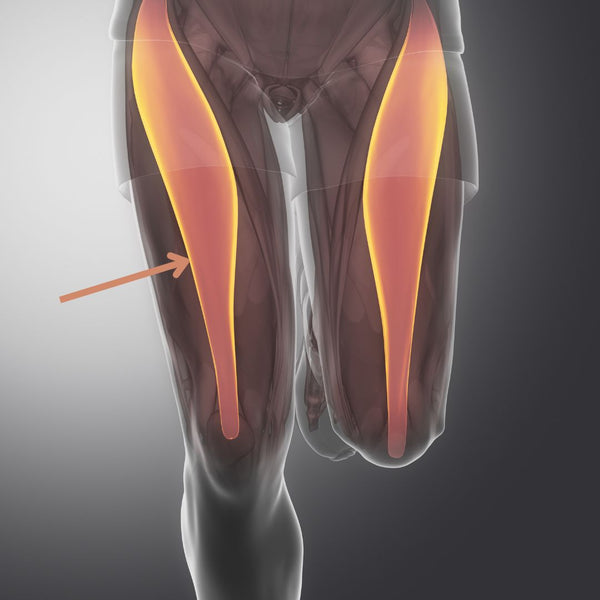
The rectus femoris is one of the four quadriceps muscles, playing a key role in knee extension and hip flexion. It’s one of the key players in your quads, helping you stand up, sit down, and sprint after your dog when it decides that “walk” means “run.”
Strengthening this muscle not only improves athletic performance and daily movements but also enhances the aesthetics of your legs. If you look at a picture of a bodybuilder’s quads, it’s the muscle that looks like a “V” shape in the middle of their thigh.
In this article, we’ll dive into the best exercises to target the rectus femoris, along with tips for maximizing your workouts.
Understanding the Rectus Femoris
Anatomy and Function:
The rectus femoris is a long, straight muscle that runs down the middle of the thigh, crossing both the hip and knee joints. So, what’s that mean? Basically, it fires up every time you walk, run, jump, squat, etc. Think of it as the utility player of the quadriceps team. It helps extend your leg as well as assists in hip flexion.
Benefits of Strengthening the Rectus Femoris:
- Improved leg strength and endurance.
- Enhanced performance in sports and daily activities.
- Better knee stability and injury prevention.
- Aesthetic benefits, such as more defined and toned legs.
6 Top Rectus Femoris Exercises
1. Leg Extension Machine
Think of the leg extension machine as the rectus femoris’ personal stage for a solo performance. With every leg lift, it gets to shine without sharing the spotlight with hamstrings or glutes. This exercise isolates the rectus femoris, so you can really concentrate on contracting every rep. If your thighs aren’t burning at the end of your set, you aren’t doing this exercise justice.
Benefits: Isolates the rectus femoris, allowing for targeted strength development.
Related: 5 Alternatives to Leg Extensions
2. Bulgarian Split Squats
If lunges had an angrier, meaner cousin, it would be the Bulgarian split squat. Balancing on one leg with the other perched behind you is the gym equivalent of showing off, but it’s not just for show. This move targets your rectus femoris while testing your balance, making this one of the most brutal exercises in the gym. If you see someone repping these out with no problems, they have some serious lower body strength.
Benefits: Engages the rectus femoris through both hip flexion and knee extension, making it a compound movement.
3. Reverse Lunges
Reverse lunges might seem like the “cool down” of lunges, but don’t be fooled; they pack a punch. By stepping backward, you put more focus on the front leg, giving your rectus femoris a chance to show what it’s made of. It’s like a trust fall for your quads—stepping back, trusting that your leg strength will catch you, and then exploding forward, showing gravity who’s the boss.
Benefits: Focuses on eccentric contraction, effectively targeting the rectus femoris while also improving balance.
4. Squats
Squats are the bread and butter of leg day, beloved by some and loathed by others. But there’s no denying their effectiveness. With every descent, your rectus femoris feels the burn, reminding you that it’s a lot easier to go down than up. It’s a full-body negotiation where your legs, glutes, and core all chime in, but the rectus femoris makes sure its voice is heard.
Benefits: Engages the entire quadriceps group, with a strong emphasis on the rectus femoris.
5. Straight Leg Raise
The straight leg raise is like the yoga of strength training—seemingly simple but deceptively challenging. By lifting your leg without bending the knee, you isolate the rectus femoris, forcing it to work overtime to keep that leg in the air. It’s a test of pure hip flexion and control, perfect for those days when you want to work hard while lying down
Benefits: Specifically targets the rectus femoris through hip flexion without knee movement, reducing strain on the knee joint.
6. Step-Ups
Step-ups are a call back to childhood days of playing on the steps, only now you’re getting fit in the process. Each step-up is a challenge to your rectus femoris, making it lift your entire body weight as you ascend. It’s like climbing a mountain one step at a time, only this time the mountain is your fitness goal, and the view from the top is a stronger, more defined leg.
Benefits: Provides both knee extension and hip flexion, hitting the rectus femoris effectively while improving balance and coordination.
Tips for Effective Rectus Femoris Training
- Warm Up: Start with a dynamic warm-up, including leg swings, bodyweight squats, and lunges, to prepare your muscles for what’s to come.
- Mind-Muscle Connection: Focus on engaging the rectus femoris during each movement, particularly during knee extension.
- Progressive Overload: Gradually increase the resistance or intensity to continually challenge the muscle and promote growth.
- Recovery: Allow adequate rest between workouts to avoid overtraining and reduce the risk of injury.
Wrap-Up
Training the rectus femoris is essential for building strong, functional, and aesthetically pleasing legs. Incorporate these exercises into your routine, and remember to pay attention to form and progression for the best results. Whether you’re an athlete looking to enhance performance or simply aiming to tone your legs, targeting the rectus femoris will take your lower body training to the next level.





